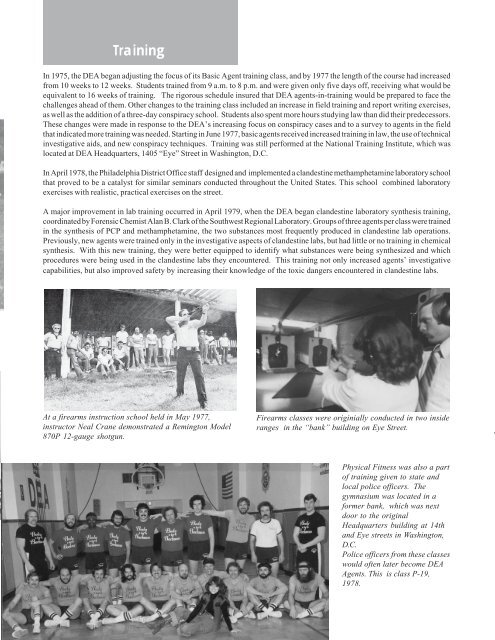Download This File - The Free Information Society
Download This File - The Free Information Society
Download This File - The Free Information Society
You also want an ePaper? Increase the reach of your titles
YUMPU automatically turns print PDFs into web optimized ePapers that Google loves.
Training<br />
In 1975, the DEA began adjusting the focus of its Basic Agent training class, and by 1977 the length of the course had increased<br />
from 10 weeks to 12 weeks. Students trained from 9 a.m. to 8 p.m. and were given only five days off, receiving what would be<br />
equivalent to 16 weeks of training. <strong>The</strong> rigorous schedule insured that DEA agents-in-training would be prepared to face the<br />
challenges ahead of them. Other changes to the training class included an increase in field training and report writing exercises,<br />
as well as the addition of a three-day conspiracy school. Students also spent more hours studying law than did their predecessors.<br />
<strong>The</strong>se changes were made in response to the DEA’s increasing focus on conspiracy cases and to a survey to agents in the field<br />
that indicated more training was needed. Starting in June 1977, basic agents received increased training in law, the use of technical<br />
investigative aids, and new conspiracy techniques. Training was still performed at the National Training Institute, which was<br />
located at DEA Headquarters, 1405 “Eye” Street in Washington, D.C.<br />
In April 1978, the Philadelphia District Office staff designed and implemented a clandestine methamphetamine laboratory school<br />
that proved to be a catalyst for similar seminars conducted throughout the United States. <strong>This</strong> school combined laboratory<br />
exercises with realistic, practical exercises on the street.<br />
A major improvement in lab training occurred in April 1979, when the DEA began clandestine laboratory synthesis training,<br />
coordinated by Forensic Chemist Alan B. Clark of the Southwest Regional Laboratory. Groups of three agents per class were trained<br />
in the synthesis of PCP and methamphetamine, the two substances most frequently produced in clandestine lab operations.<br />
Previously, new agents were trained only in the investigative aspects of clandestine labs, but had little or no training in chemical<br />
synthesis. With this new training, they were better equipped to identify what substances were being synthesized and which<br />
procedures were being used in the clandestine labs they encountered. <strong>This</strong> training not only increased agents’ investigative<br />
capabilities, but also improved safety by increasing their knowledge of the toxic dangers encountered in clandestine labs.<br />
At a firearms instruction school held in May 1977,<br />
instructor Neal Crane demonstrated a Remington Model<br />
870P 12-gauge shotgun.<br />
39<br />
Firearms classes were originially conducted in two inside<br />
ranges in the “bank” building on Eye Street.<br />
Physical Fitness was also a part<br />
of training given to state and<br />
local police officers. <strong>The</strong><br />
gymnasium was located in a<br />
former bank, which was next<br />
door to the original<br />
Headquarters building at 14th<br />
and Eye streets in Washington,<br />
D.C.<br />
Police officers from these classes<br />
would often later become DEA<br />
Agents. <strong>This</strong> is class P-19,<br />
1978.

















